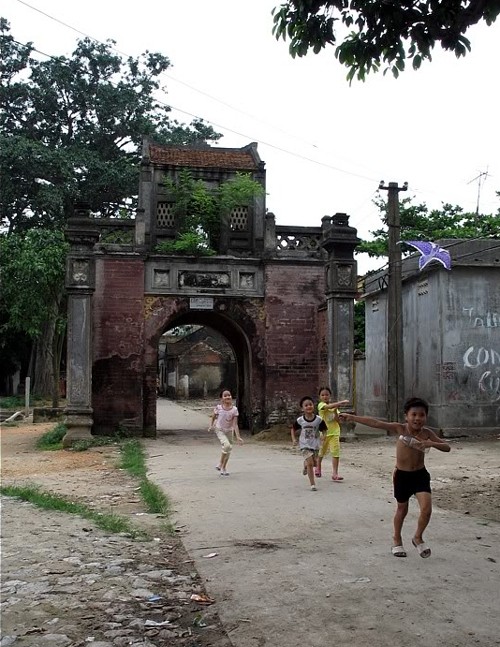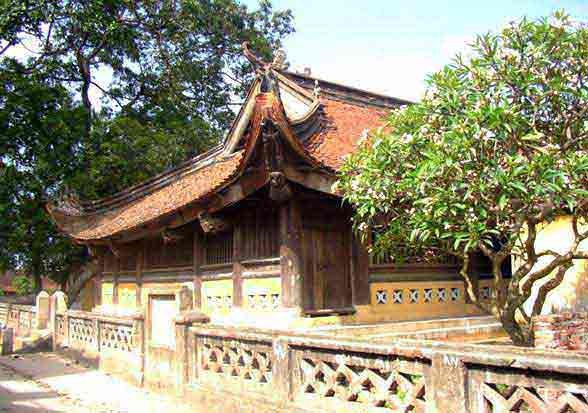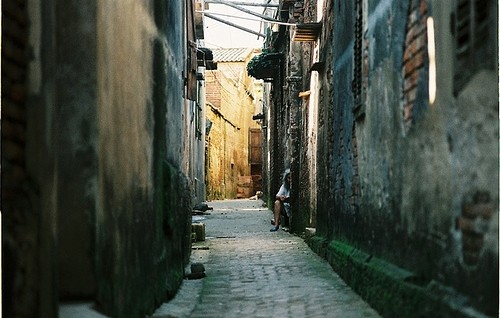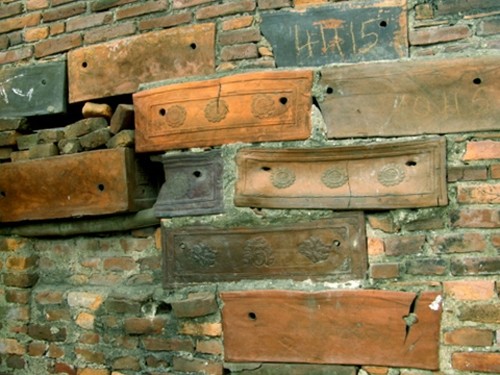Discover the cultural heart of Vietnam! The Tho Ha village gate is more than just an entrance; it’s a symbol of history, architecture, and community spirit that has stood the test of time. Let SIXT.VN guide you through the ancient village of Tho Ha to uncover the hidden gems of Northern Vietnam. We offer seamless travel experiences, from airport transfers to curated tours, ensuring your journey is unforgettable. Explore Vietnamese heritage with us today!
1. What Makes the Tho Ha Village Gate Historically Significant?
The Tho Ha village gate is historically significant because it represents the cultural and architectural heritage of the Northern Delta region of Vietnam. Constructed as part of a larger complex of historical structures, including the Tho Ha communal house and ancient pagodas, the gate served as a symbolic and physical entry point to the village, delineating its boundaries and protecting its community. It’s a testament to the village’s long-standing history, dating back to the 14th century when Tho Ha thrived as a prominent pottery center. The gate embodies the traditions, craftsmanship, and communal values of the Vietnamese people.
According to historical records, the construction of such gates was often linked to periods of prosperity and stability, reflecting the village’s ability to invest in communal projects that enhanced its identity and security. The Tho Ha village gate, in particular, stands out due to its unique architectural style, incorporating elements of local craftsmanship and design. As noted by the Vietnam National Administration of Tourism, cultural heritage sites like Tho Ha offer invaluable insights into Vietnam’s rich history and cultural identity, drawing visitors keen to understand the country’s past and present.
2. How Does the Tho Ha Village Gate Reflect Traditional Vietnamese Architecture?
The Tho Ha village gate exemplifies traditional Vietnamese architecture through its design, materials, and integration with the surrounding environment. Key architectural features include:
- Materials: The gate is primarily constructed from traditional materials such as bricks and terracotta, reflecting the village’s heritage as a pottery center. These materials, locally sourced, contribute to the gate’s unique aesthetic and its connection to the land.
- Design: The gate’s design often incorporates elements of traditional Vietnamese aesthetics, such as curved roofs, intricate carvings, and symbolic motifs. These elements reflect the cultural values and beliefs of the community.
- Integration: The gate is carefully positioned to complement the surrounding landscape, often aligning with feng shui principles to ensure harmony and balance. This integration enhances the gate’s visual appeal and its significance as a landmark.
According to research from the Ministry of Culture, Sports and Tourism, the architectural style of structures like the Tho Ha village gate is a reflection of the socio-cultural context in which they were built. This gate showcases the sophisticated craftsmanship and artistic sensibilities of the Vietnamese people. For travelers interested in exploring traditional Vietnamese architecture, the Tho Ha village gate is a must-see destination.
 Tho Ha Village Gate Overview
Tho Ha Village Gate Overview
3. What Cultural Significance Does the Tho Ha Village Gate Hold for Locals?
The Tho Ha village gate holds immense cultural significance for the local community, serving as a symbol of identity, unity, and historical pride. The gate is more than just an entrance; it’s a representation of the village’s heritage, traditions, and values.
- Symbol of Identity: The gate acts as a visual marker of the village’s identity, distinguishing it from neighboring communities and reinforcing a sense of belonging among residents.
- Source of Pride: Local people take great pride in the gate’s historical and architectural significance, viewing it as a testament to their ancestors’ craftsmanship and cultural legacy.
- Venue for Celebrations: The gate often serves as a gathering place for community events, festivals, and ceremonies, reinforcing social bonds and collective identity.
According to ethnographic studies conducted by the Vietnam Academy of Social Sciences, the village gate plays a central role in shaping the social and cultural life of rural communities in Vietnam. It’s a focal point for collective memory, cultural transmission, and community cohesion. As you explore Tho Ha, you’ll witness firsthand how the village gate continues to be cherished and revered by local residents.
4. How Has the Tho Ha Village Gate Influenced Art and Literature?
The Tho Ha village gate has significantly influenced art and literature, serving as a recurring motif in paintings, photographs, poems, and stories that celebrate the beauty and cultural richness of rural Vietnam.
- Visual Arts: The gate’s distinctive architecture and historical ambiance have inspired countless artists to capture its image on canvas and film. These artistic representations often emphasize the gate’s timeless quality and its role as a symbol of Vietnamese heritage.
- Literary Works: The Tho Ha village gate has also found its way into literary works, where it is often used as a metaphor for tradition, community, and the enduring spirit of the Vietnamese people. Writers use the gate as a backdrop for stories that explore themes of identity, memory, and cultural continuity.
- Tourism Promotion: The image of the Tho Ha village gate is frequently used in tourism campaigns and promotional materials, attracting visitors who are eager to experience the authentic beauty and cultural charm of rural Vietnam.
As noted by art critics and literary scholars, the Tho Ha village gate serves as a powerful symbol that resonates with artists and writers seeking to capture the essence of Vietnamese culture. Its influence extends beyond the local community, inspiring creative works that celebrate the country’s rich heritage on a global scale.
5. What Tourism Opportunities Surround the Tho Ha Village Gate?
The Tho Ha village gate offers a wealth of tourism opportunities, inviting visitors to explore the historical, cultural, and natural attractions of the surrounding area.
- Heritage Tours: Guided tours of the Tho Ha village gate and other historical sites provide insights into the village’s rich past and architectural heritage.
- Cultural Immersion: Visitors can participate in traditional craft workshops, cooking classes, and cultural performances, gaining firsthand experience of Vietnamese customs and traditions.
- Eco-Tourism: The picturesque countryside surrounding Tho Ha offers opportunities for hiking, cycling, and exploring the natural beauty of the Red River Delta.
- Homestay Experiences: Staying with local families allows visitors to immerse themselves in the daily life of the village, fostering cultural exchange and supporting the local economy.
According to data from the General Statistics Office of Vietnam, cultural tourism is a rapidly growing sector, with increasing numbers of travelers seeking authentic experiences that connect them to local communities and their heritage. Tho Ha, with its well-preserved village gate and cultural attractions, is perfectly positioned to capitalize on this trend.
6. How Does the Tho Ha Village Gate Compare to Other Village Gates in Vietnam?
The Tho Ha village gate stands out among other village gates in Vietnam due to its unique architectural style, historical significance, and the rich cultural context in which it is situated.
| Feature | Tho Ha Village Gate | Other Village Gates |
|---|---|---|
| Architectural Style | Incorporates local materials like terracotta, reflecting the village’s pottery heritage. | Varies depending on the region, often using wood or stone. |
| Historical Significance | Part of an ancient village with a long history of pottery production. | Historical significance varies, often linked to local events and traditions. |
| Cultural Context | Integrated into a vibrant community with strong cultural traditions and crafts. | Cultural context depends on the specific village and its unique customs. |
While many village gates across Vietnam serve as symbolic entrances and communal landmarks, the Tho Ha gate’s distinctive character and historical depth set it apart. It’s a prime example of how local craftsmanship and cultural identity can shape architectural forms, creating a unique and memorable landmark.
7. What Stories And Legends Are Associated With the Tho Ha Village Gate?
The Tho Ha village gate is steeped in local lore, with numerous stories and legends passed down through generations, adding to its mystique and cultural significance.
- Protective Spirits: Some legends claim that the gate is guarded by protective spirits who ward off evil and ensure the village’s prosperity.
- Historical Events: Stories recount historical events that took place at or near the gate, such as battles, festivals, and important community gatherings.
- Symbolic Meanings: Local tales often attribute symbolic meanings to the gate’s architectural features, such as the carvings, colors, and materials used in its construction.
These stories and legends contribute to the gate’s cultural significance, imbuing it with a sense of magic, mystery, and historical depth. They also serve as a means of preserving and transmitting cultural values from one generation to the next. When you visit Tho Ha, be sure to ask local residents to share their stories about the village gate!
8. What Challenges Does the Tho Ha Village Gate Face in Terms of Preservation?
The Tho Ha village gate faces several challenges in terms of preservation, including environmental factors, urbanization, and the need for sustainable tourism management.
- Environmental Factors: Exposure to the elements, such as rain, humidity, and temperature fluctuations, can cause deterioration of the gate’s materials and structural integrity.
- Urbanization: The encroachment of modern development can threaten the gate’s surrounding landscape and disrupt the traditional character of the village.
- Sustainable Tourism: Managing the impact of tourism is crucial to ensure that the gate and its surrounding environment are protected for future generations.
To address these challenges, preservation efforts must focus on:
- Restoration: Regular maintenance and restoration work to repair damage and prevent further deterioration.
- Conservation: Implementing measures to protect the gate’s surrounding environment and preserve the village’s traditional character.
- Community Engagement: Involving local residents in preservation efforts to ensure that their voices are heard and their cultural values are respected.
According to heritage conservation experts, sustainable preservation requires a holistic approach that balances the needs of the present with the long-term interests of the community and its cultural heritage.
 Tho Ha Temple – A Unique Architectural Art
Tho Ha Temple – A Unique Architectural Art
9. How Can Tourists Best Experience the Tho Ha Village Gate?
Tourists can best experience the Tho Ha village gate by planning their visit carefully, engaging with local guides, and respecting the cultural significance of the site.
- Plan Ahead: Research the history and cultural significance of the Tho Ha village gate before your visit to gain a deeper appreciation for its importance.
- Hire a Local Guide: A knowledgeable guide can provide insights into the gate’s architecture, history, and cultural context, as well as introduce you to local customs and traditions.
- Respect Local Culture: Dress modestly, be mindful of your behavior, and ask permission before taking photographs of local residents or religious sites.
- Support Local Businesses: Patronize local restaurants, shops, and accommodations to support the village’s economy and contribute to its sustainable development.
- Take Your Time: Allow ample time to explore the Tho Ha village gate and its surrounding attractions, soaking in the atmosphere and engaging with the local community.
By following these tips, you can ensure a memorable and meaningful experience that respects the cultural heritage of Tho Ha and its people.
10. What Are the Future Prospects for the Tho Ha Village Gate and Its Surrounding Community?
The future prospects for the Tho Ha village gate and its surrounding community are promising, with opportunities for sustainable tourism development, cultural preservation, and economic growth.
- Sustainable Tourism: Developing tourism in a responsible and sustainable manner can generate income for local residents, support cultural preservation efforts, and protect the environment.
- Cultural Preservation: Continued efforts to preserve and promote the village’s cultural heritage can enhance its appeal to tourists and reinforce its identity as a unique cultural destination.
- Economic Growth: Tourism can stimulate economic growth in the village, creating new jobs, supporting local businesses, and improving the quality of life for residents.
To realize these prospects, it’s essential to:
- Invest in Infrastructure: Improve transportation, accommodation, and other facilities to enhance the visitor experience.
- Promote Cultural Education: Educate visitors and local residents about the importance of cultural preservation and sustainable tourism.
- Foster Community Participation: Involve local residents in decision-making processes to ensure that their voices are heard and their interests are protected.
With careful planning, community engagement, and a commitment to sustainable development, the Tho Ha village gate and its surrounding community can thrive for generations to come. Let SIXT.VN be your partner in exploring this captivating destination, offering seamless travel solutions that enhance your journey.
11. What is Tho Ha pottery village?
Tho Ha pottery village is one of Vietnam’s oldest ceramic centers, known for its unique pottery since the 14th century. The ceramics are celebrated for being waterproof, producing a bell-like sound when struck, and having a smooth brown color.
The village’s exclusive focus on household pottery, jars, and pots has allowed it to refine its techniques over centuries, creating products that are both durable and aesthetically pleasing. According to the Bac Giang Department of Culture, Sports and Tourism, Tho Ha’s pottery is a significant cultural asset, attracting tourists and researchers interested in traditional Vietnamese crafts.
12. How does the prosperity of Tho Ha pottery impact the local architecture?
The prosperity generated by Tho Ha pottery has greatly influenced the village’s architecture. This is evident in the construction of communal houses, pagodas, and even the village gate, all funded by the pottery trade.
The use of pottery fragments in the construction of walls and buildings is a unique characteristic of Tho Ha, showcasing the village’s resourcefulness and artistic flair. Financial support from the pottery industry allowed local artisans to create elaborate structures, reflecting the community’s wealth and cultural values. As highlighted by the Vietnam Cultural Heritage Research Association, the integration of economic prosperity with cultural expression in Tho Ha provides a model for sustainable cultural development.
13. What is the architectural significance of Tho Ha Temple?
Tho Ha Temple, or communal house, is a significant architectural landmark in the Kinh Bac region, renowned as a masterpiece of Vietnamese carved art. Built in 1692 during the reign of King Le Hy Tong, it represents the spiritual and cultural space of the Vietnamese people.
The temple’s intricate sculptures and large scale architecture have been recognized by the Vien Dong Bac Co Museum, which ranks it as a national architectural and artistic monument. The temple houses nine ancient steles, offering valuable cultural and historical insights. According to architectural historians at the National University of Civil Engineering, Tho Ha Temple is an exceptional example of traditional Vietnamese architecture, showcasing the sophisticated craftsmanship and artistic sensibilities of the period.
 Small Alley in Tho Ha Village
Small Alley in Tho Ha Village
14. What role does Tho Ha temple play in the community’s spiritual life?
Tho Ha temple is a central hub for the community’s spiritual life, serving as a place of worship and a center for learning. Built in the 17th century, the temple is dedicated to Confucius, four Kings, and 72 fairies, and is considered the cradle of learning in Tho Ha.
During examination seasons, candidates visit the temple to offer incense and prayers for success, highlighting the temple’s role in education and aspiration. The temple’s significance as a spiritual center attracts many tourists, particularly those interested in Vietnamese culture and traditions. According to the Vietnam Institute for Culture and Arts Studies, Tho Ha Temple is a vital component of the village’s cultural identity, embodying its values, beliefs, and traditions.
15. What attracts tourists to Tho Ha ancient village?
Tho Ha ancient village attracts tourists with its ancient beauty, pure Vietnamese atmosphere, and the hospitality of its local people. Its proximity to Hanoi makes it easily accessible, drawing those interested in architecture, art, and Vietnamese culture.
The village’s well-preserved architecture, including the village gate, ancient houses, and communal structures, provides a glimpse into traditional Vietnamese life. The peaceful setting and friendly locals enhance the visitor experience, offering a contrast to the bustling city. According to tourism surveys conducted by the Vietnam National Administration of Tourism, cultural heritage and authentic experiences are key motivators for tourists visiting Tho Ha, making it a popular destination for both domestic and international travelers.
16. How do unique house walls in Tho Ha village contribute to the village’s charm?
The unique house walls in Tho Ha village significantly contribute to its charm by showcasing the village’s history and pottery traditions. Constructed from pottery fragments and traditional materials, these walls are a visual representation of the village’s identity.
The intricate patterns and textures of the walls provide a distinctive backdrop to the village’s narrow alleyways, creating a captivating atmosphere for visitors. These unique architectural details enhance the overall aesthetic appeal of Tho Ha, making it a popular destination for photographers and art enthusiasts. According to the Vietnam Association of Architects, the house walls in Tho Ha are a prime example of sustainable architecture, repurposing local materials to create aesthetically pleasing and functional structures.
17. What are some of the must-see attractions near Tho Ha village?
Near Tho Ha village, must-see attractions include the ancient Tho Ha communal house, the Tho Ha pagoda, and the surrounding traditional craft villages. These sites offer a comprehensive glimpse into the region’s rich cultural and historical tapestry.
The communal house showcases exquisite Vietnamese carving art, while the pagoda provides a serene space for reflection and appreciation of religious architecture. Exploring nearby craft villages offers opportunities to witness traditional pottery-making techniques and purchase unique souvenirs. According to local tourism guides, visitors often combine a trip to Tho Ha with visits to other cultural sites in Bac Giang province, creating a well-rounded and immersive travel experience.
 Unique House Wall in Tho Ha Village
Unique House Wall in Tho Ha Village
18. How can SIXT.VN enhance a trip to Tho Ha?
SIXT.VN can significantly enhance a trip to Tho Ha by providing comprehensive travel solutions tailored to the needs of international visitors. These include airport transfers, hotel bookings, and guided tours, ensuring a seamless and enriching travel experience.
Our services offer convenience and reliability, allowing visitors to focus on exploring the cultural and historical treasures of Tho Ha without logistical worries. With SIXT.VN, travelers can access curated itineraries, reliable transportation, and comfortable accommodations, all designed to enhance their journey. According to customer feedback, SIXT.VN’s commitment to quality and customer satisfaction makes it an ideal partner for exploring Vietnam’s cultural gems.
19. What kind of cultural experiences can tourists have in Tho Ha?
Tourists in Tho Ha can immerse themselves in a range of authentic cultural experiences, including pottery workshops, traditional festivals, and interactions with local artisans. These experiences offer deep insights into the village’s heritage and traditions.
Participating in pottery workshops allows visitors to learn about the art of ceramic making from skilled artisans, creating their own unique pieces. Attending local festivals provides opportunities to witness traditional music, dance, and culinary practices, celebrating the village’s vibrant cultural life. According to the Ministry of Culture, Sports and Tourism, cultural tourism experiences like those in Tho Ha are vital for preserving and promoting Vietnam’s cultural heritage.
20. How does the sunset scene on the river in Tho Ha contribute to the village’s charm?
The sunset scene on the river in Tho Ha significantly enhances the village’s charm, offering a picturesque and serene backdrop to the traditional landscape. The tranquil waters reflecting the golden hues of the setting sun create a magical atmosphere.
This serene environment adds to the village’s appeal as a peaceful retreat from the urban bustle, providing visitors with a chance to relax and connect with nature. The sunset scene is a favorite subject for photographers and artists, capturing the essence of Tho Ha’s beauty. According to travel bloggers, the sunset on the river in Tho Ha is a must-see experience, adding a touch of romance and tranquility to any visit.
Why Choose SIXT.VN for Your Tho Ha Adventure?
Planning a trip to Tho Ha? Let SIXT.VN take the stress out of your travel arrangements. We offer a range of services designed to make your journey seamless and enjoyable:
- Airport Transfers: Arrive in comfort with our reliable and efficient airport transfer service.
- Hotel Bookings: Choose from a curated selection of hotels to suit your budget and preferences.
- Guided Tours: Explore Tho Ha with our expert local guides, who will bring the village’s history and culture to life.
Contact us today to start planning your unforgettable Tho Ha adventure!
Address: 260 Cau Giay, Hanoi, Vietnam
Hotline/Whatsapp: +84 986 244 358
Website: SIXT.VN
Frequently Asked Questions (FAQ) about Tho Ha Village Gate
1. What is the best time to visit Tho Ha village?
The best time to visit Tho Ha is during the dry season (October to April) when the weather is pleasant for exploring the village and its surroundings.
2. How do I get to Tho Ha village from Hanoi?
You can reach Tho Ha village from Hanoi by car or bus, which takes about 1.5 to 2 hours. SIXT.VN offers convenient transportation options for a hassle-free journey.
3. Are there any entrance fees to visit Tho Ha village gate?
There are generally no entrance fees to visit Tho Ha village gate, but some attractions within the village may have admission charges.
4. What should I wear when visiting Tho Ha village?
Dress modestly and respectfully, especially when visiting religious sites. Comfortable walking shoes are recommended for exploring the village.
5. Can I hire a local guide in Tho Ha village?
Yes, local guides are available in Tho Ha village to provide insights into the history, culture, and architecture of the area. SIXT.VN can arrange for a knowledgeable guide to accompany you.
6. Are there any accommodations available in Tho Ha village?
While there are limited accommodations within Tho Ha village itself, you can find a range of hotels and guesthouses in nearby towns. SIXT.VN offers hotel booking services to help you find the perfect place to stay.
7. What local specialties should I try in Tho Ha village?
Be sure to try the local pottery products, traditional cakes, and other regional dishes when visiting Tho Ha village.
8. How can I support the local community in Tho Ha village?
You can support the local community by purchasing local products, dining at local restaurants, and engaging with local artisans and guides.
9. Is it safe to travel to Tho Ha village?
Yes, Tho Ha village is generally a safe destination for tourists. However, it’s always wise to take normal safety precautions, such as being aware of your surroundings and protecting your belongings.
10. Can SIXT.VN help me plan a customized tour of Tho Ha village?
Yes, SIXT.VN specializes in creating customized tours tailored to your interests and preferences. Contact us to discuss your ideal Tho Ha itinerary.
Let SIXT.VN be your trusted partner in exploring the beauty and cultural richness of Tho Ha village. We ensure your trip will be memorable!



